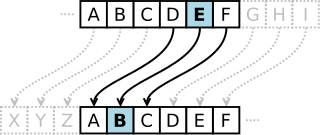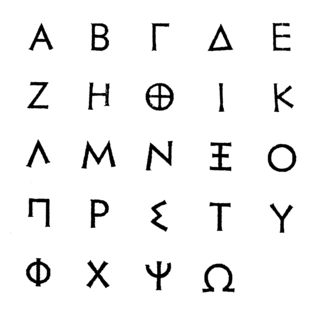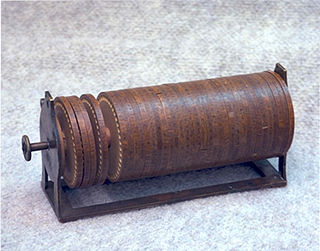Related Research Articles

In cryptography, a cipher is an algorithm for performing encryption or decryption—a series of well-defined steps that can be followed as a procedure. An alternative, less common term is encipherment. To encipher or encode is to convert information into cipher or code. In common parlance, "cipher" is synonymous with "code", as they are both a set of steps that encrypt a message; however, the concepts are distinct in cryptography, especially classical cryptography.

Cryptanalysis refers to the process of analyzing information systems in order to understand hidden aspects of the systems. Cryptanalysis is used to breach cryptographic security systems and gain access to the contents of encrypted messages, even if the cryptographic key is unknown.

In cryptography, a transposition cipher is a method of encryption which scrambles the positions of characters (transposition) without changing the characters themselves. Transposition ciphers reorder units of plaintext according to a regular system to produce a ciphertext which is a permutation of the plaintext. They differ from substitution ciphers, which do not change the position of units of plaintext but instead change the units themselves. Despite the difference between transposition and substitution operations, they are often combined, as in historical ciphers like the ADFGVX cipher or complex high-quality encryption methods like the modern Advanced Encryption Standard (AES).

In cryptography, a Caesar cipher, also known as Caesar's cipher, the shift cipher, Caesar's code, or Caesar shift, is one of the simplest and most widely known encryption techniques. It is a type of substitution cipher in which each letter in the plaintext is replaced by a letter some fixed number of positions down the alphabet. For example, with a left shift of 3, D would be replaced by A, E would become B, and so on. The method is named after Julius Caesar, who used it in his private correspondence.

The Vigenère cipher is a method of encrypting alphabetic text where each letter of the plaintext is encoded with a different Caesar cipher, whose increment is determined by the corresponding letter of another text, the key.

An autokey cipher is a cipher that incorporates the message into the key. The key is generated from the message in some automated fashion, sometimes by selecting certain letters from the text or, more commonly, by adding a short primer key to the front of the message.
In cryptography, coincidence counting is the technique of putting two texts side-by-side and counting the number of times that identical letters appear in the same position in both texts. This count, either as a ratio of the total or normalized by dividing by the expected count for a random source model, is known as the index of coincidence, or IC for short.

In cryptanalysis, frequency analysis is the study of the frequency of letters or groups of letters in a ciphertext. The method is used as an aid to breaking classical ciphers.

In cryptography, ciphertext or cyphertext is the result of encryption performed on plaintext using an algorithm, called a cipher. Ciphertext is also known as encrypted or encoded information because it contains a form of the original plaintext that is unreadable by a human or computer without the proper cipher to decrypt it. This process prevents the loss of sensitive information via hacking. Decryption, the inverse of encryption, is the process of turning ciphertext into readable plaintext. Ciphertext is not to be confused with codetext because the latter is a result of a code, not a cipher.

The Beale ciphers are a set of three ciphertexts, one of which allegedly states the location of a buried treasure of gold, silver and jewels estimated to be worth over US$43 million as of January 2018. Comprising three ciphertexts, the first (unsolved) text describes the location, the second (solved) ciphertext accounts the content of the treasure, and the third (unsolved) lists the names of the treasure's owners and their next of kin.
The affine cipher is a type of monoalphabetic substitution cipher, where each letter in an alphabet is mapped to its numeric equivalent, encrypted using a simple mathematical function, and converted back to a letter. The formula used means that each letter encrypts to one other letter, and back again, meaning the cipher is essentially a standard substitution cipher with a rule governing which letter goes to which. As such, it has the weaknesses of all substitution ciphers. Each letter is enciphered with the function (ax + b) mod 26, where b is the magnitude of the shift.

Kryptos is a distributed sculpture by the American artist Jim Sanborn located on the grounds of the Central Intelligence Agency (CIA) headquarters, the George Bush Center for Intelligence in Langley, Virginia. Since its dedication on November 3, 1990, there has been much speculation about the meaning of the four encrypted messages it bears. Of these four messages, the first three have been solved, while the fourth message remains one of the most famous unsolved codes in the world. The sculpture continues to be of interest to cryptanalysts, both amateur and professional, who are attempting to decipher the fourth passage. The artist has so far given four clues to this passage.
In cryptography, the ADFGVX cipher was a manually applied field cipher used by the Imperial German Army during World War I. It was used to transmit messages secretly using wireless telegraphy. ADFGVX was in fact an extension of an earlier cipher called ADFGX which was first used on 1 March 1918 on the German Western Front. ADFGVX was applied from 1 June 1918 on both the Western Front and Eastern Front.

The Polybius square, also known as the Polybius checkerboard, is a device invented by the ancient Greeks Cleoxenus and Democleitus, and made famous by the historian and scholar Polybius. The device is used for fractionating plaintext characters so that they can be represented by a smaller set of symbols, which is useful for telegraphy, steganography, and cryptography. The device was originally used for fire signalling, allowing for the coded transmission of any message, not just a finite number of predetermined options as was the convention before.
In classical cryptography, the bifid cipher is a cipher which combines the Polybius square with transposition, and uses fractionation to achieve diffusion. It was invented around 1901 by Felix Delastelle.

The Jefferson disk, also called the Bazeries cylinder or wheel cypher, was a cipher system commonly attributed to Thomas Jefferson that uses a set of wheels or disks, each with letters of the alphabet arranged around their edge in an order, which is different for each disk and is usually ordered randomly.
The four-square cipher is a manual symmetric encryption technique. It was invented by the French cryptographer Felix Delastelle.
The Two-square cipher, also called double Playfair, is a manual symmetric encryption technique. It was developed to ease the cumbersome nature of the large encryption/decryption matrix used in the four-square cipher while still being slightly stronger than the single-square Playfair cipher.
The Beaufort cipher, invented by some Giovanni Sestri in early 18th century but widely attributed to Sir Francis Beaufort, is a substitution cipher similar to the Vigenère cipher, with a slightly modified enciphering mechanism and tableau. Its most famous application was in a rotor-based cipher machine, the Hagelin M-209. The Beaufort cipher is based on the Beaufort square which is essentially the same as a Vigenère square but in reverse order starting with the letter "Z" in the first row, where the first row and the last column serve the same purpose.

The Alberti Cipher, created in 1467 by Italian architect Leon Battista Alberti, was one of the first polyalphabetic ciphers. In the opening pages of his treatise De componendis cifris he explained how his conversation with the papal secretary Leonardo Dati about a recently developed movable type printing press led to the development of his cipher wheel.
References
- Shulman, David (nom: Ab Struse). "The D'Agapeyeff Cryptogram: A Challenge", The Cryptogram, April/May 1952: 39-40, 46.
- Shulman, David (nom: Ab Struse). "D'Agapeyeff Cipher: Postscript", The Cryptogram, March/April 1959: 80-81.
- Barker, Wayne G (1978). "The Unsolved D'Agapeyeff Cipher", Cryptologia, 2(2): 144-147
- List of famous unsolved codes, maintained by cryptographer Elonka Dunin
- D'Agapeyeff, Alexander. Codes and Ciphers, 1939, Oxford University Press, p. 158